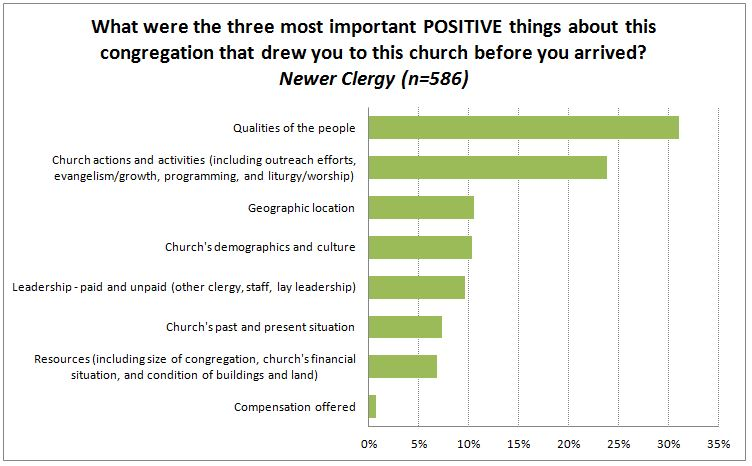When a pastor or priest first considers a call to a church—or is assigned to a church—what stands out as important? The familiarity of the worship service? The grandeur of the architecture? The friendliness of the people?
We found that newer clergy, like more seasoned clergy, pay careful attention to the people of a church: what they are like, how they act with each other and toward newcomers, and how they are together as a community. And their first impressions about the people of a church can shape their ministry in that place in profound ways.
When people come to a new place, they form initial impressions—positive and negative—based on what they see, hear, and experience. Clergy are no different. These initial impressions shape how people respond to the new place, including what will attract them and what will repel or alarm them.
For pastors and priests, the most important impressions they form are those of the people of the church. These impressions begin to form during the first few times of contact.
We asked survey participants to write down the three most important positive impressions that initially attracted them to the church where they recently worked. Then we asked them to submit the three most important negative impressions about that church which gave them pause for concern, alarm, or reflection before they arrived.
First, the positive. Newer clergy’s primary positive impressions focus more on the people of a church than on anything else when considering (or accepting assignment of) a position there. No matter what else is present or absent in a church, clergy seem most invested in finding what is good about the people. More than 30% of all positive impressions were about the qualities of individuals in the church or the overall social and interpersonal tone of the congregation. Some of the most frequently stated qualities of the people were
- openness to change or new ideas;
- a welcoming attitude toward others;
- energy or enthusiasm about the church and its work (often expressed in terms of “vibrancy”); or
- spiritual strengths such as authentic faith or the desire to grow spiritually.
In addition, just over 10% of positive impressions about churches had to do with their internal culture and demographics. Clergy reported being attracted to the congregations they served because they
- included families, children, and young people;
- were affirming and inclusive (of LGBT people, but also of minorities and of women in leadership roles);
- had some economic, racial, and cultural diversity; or
- were at least moderately liberal or progressive on theological, social, and political issues.
Comments about the church’s various actions and activities—including community outreach, evangelism efforts, church programs, and worship services—came in second, with more than 23% of all valid responses.
About 10% of responses focused on the church’s geographic location. Sometimes the survey respondents described the location as a positive aspect of church life (for example, “urban setting” or “the simplicity of a small country parish with down-to-earth people”), but most often they focused on an attractive region of the country, nearness of family or friends, or opportunities for a spouse or family members.
Positive assessments of church assets such as the size of the congregation, its financial situation, and the condition of the church buildings and grounds were significantly less common. So were comments about a current or past event at the church. Less than 1% of responses named the compensation package offered as part of the attraction.
Second, the negative. Clergy generally take note of a wider range of negative matters regarding a church: not only the people of the congregation but also the church’s current situation and past track record, its financial state, the size of the congregation, and the condition of the building and grounds.
In comparison to the percentage of positive impressions about the people (30%), negative comments about the people of the congregation only accounted for 17% of all negative impressions. These negative people-impressions were mostly related to clergy seeing people in the congregation who
- seemed resistant to change;
- acted hostile or contentious;
- participated in dysfunctional relationships or systems;
- exercised poor use of boundaries (e.g., a long-time pastor who has retired from his position of leadership continuing to worship with the congregation on Sunday);
- showed signs of complacency or stagnation; or
- held unrealistic expectations of pastors or priests.
Joining this were negative impressions about the internal culture and demographics of the church community (10%).
More on the minds of newer clergy were the negative impressions they formed of the church’s assets and resources. More than 18% of negative impressions concerned the size of the church membership, the condition of the church property, and especially the state of the church’s finances—for example, “large mortgage payments,” “there were no reserves financially,” “community and church are both very poor,” “low pledging/giving,” and “need for a building campaign.”
Newer priests and pastors also recalled their awareness of troubling situations that the congregation was facing at the time or had struggled with in the past. Approximately 18% of negative impressions were about situations such as
- a history of conflict in the church;
- a recent or ongoing conflict in the congregation;
- incidents of clergy or staff misconduct;
- high turnover of clergy or staff; or
- leadership positions that had been held by previous clergy members for an unusually long duration.
Less frequent were negative impressions that concerned the church’s leadership, including the staff, lay leaders, and other ordained ministers, if any (11%); the church’s geographic location (10%); and actions and activities at the church (10%). Only 2.5% of negative impressions reported were about the compensation package that came with the position.
Our analyses of positive first impressions in particular echoes patterns we have observed in earlier studies: It seems that newer clergy’s decisions about whether to accept a church’s call and their attitudes about going to that church are most heavily influenced by their impressions of the people there.
Clergy appear to enter positions in new churches aware of some of the challenges they will face, such as difficult personalities, financial struggles, and/or dysfunctional dynamics. In the situations explored by these survey questions, however, the potential downsides were not daunting enough to convince the pastor or priest not to accept the call or assignment.
In the process of conducting 39 in-depth interviews with clergy, we heard numerous stories about clergy following calls to churches in unexpected places, because they felt a deep connection to the people of the congregation.
The Reverend Ryan Owens described moving from the Midwest to Texas to serve at St. John’s Lutheran Church. “I think there was a little part of me that was looking for an excuse not to go, because it was inconvenient. We don’t have any reason to be there. It’s not a place we’ve always dreamed of living. We don’t have family there, you know, or any connections—we’re making some, thankfully….
“They flew down just me in March and I met with the Call Committee. They brought me back and [my wife] as well in June, and that’s when I met a bunch of people and did some bible studies, preached on Sunday morning. And by the end of that, [I thought] you know, I think I kind of love these people already. So maybe that’s my sign—I could love these people, and that’s what I’ve been taught and just what I had come to feel is what’s necessary for a call to work.”
Related Articles





